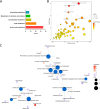Dysregulation of cerebrospinal fluid metabolism profiles in spinal muscular atrophy patients: a case control study
- PMID: 39175089
- PMCID: PMC11342544
- DOI: 10.1186/s13052-024-01726-6
Dysregulation of cerebrospinal fluid metabolism profiles in spinal muscular atrophy patients: a case control study
Abstract
Background: Spinal muscular atrophy (SMA) is a neurodegenerative disorder. Although prior studies have investigated the metabolomes of SMA in various contexts, there is a gap in research on cerebrospinal fluid (CSF) metabolomics compared to healthy controls. CSF metabolomics can provide insights into central nervous system function and patient outcomes. This study aims to investigate CSF metabolite profiles in untreated SMA patients to enhance our understanding of SMA metabolic dysregulation.
Methods: This case control study included 15 SMA patients and 14 control subjects. CSF samples were collected, and untargeted metabolomics was conducted to detect metabolites in SMA and control groups.
Results: A total of 118 metabolites abundance were significantly changed between the SMA and control groups. Of those, 27 metabolites with variable importance for the projection (VIP) ≥ 1.5 were identified. The top 5 differential metabolites were N-acetylneuraminic acid (VIP = 2.38, Fold change = 0.43, P = 5.49 × 10-5), 2,3-dihydroxyindole (VIP = 2.33, Fold change = 0.39, P = 1.81 × 10-4), lumichrome (VIP = 2.30, Fold change = 0.48, P = 7.90 × 10-5), arachidic acid (VIP = 2.23, Fold change = 10.79, P = 6.50 × 10-6), and 10-hydroxydecanoic acid (VIP = 2.23, Fold change = 0.60, P = 1.44 × 10-4). Cluster analysis demonstrated that the differentially metabolites predominantly clustered within two main categories: protein and amino acid metabolism, and lipid metabolism.
Conclusions: The findings highlight the complexity of SMA, with widespread effects on multiple metabolic pathways, particularly in amino acid and lipid metabolism. N-acetylneuraminic acid may be a potential treatment for functional improvement in SMA. The exact mechanisms and potential therapeutic targets associated with metabolic dysregulation in SMA require further investigation.
Keywords: Cerebrospinal fluid; Metabolic disorder; Metabolomics; N-acetylneuraminic acid; Spinal muscular atrophy.
© 2024. The Author(s).
Conflict of interest statement
The authors declare that they have no competing interests.
Figures




Similar articles
-
Thrombospondin-4 as potential cerebrospinal fluid biomarker for therapy response in pediatric spinal muscular atrophy.J Neurol. 2024 Oct;271(10):7000-7011. doi: 10.1007/s00415-024-12670-0. Epub 2024 Sep 6. J Neurol. 2024. PMID: 39240344 Free PMC article.
-
Proteomics profiling and machine learning in nusinersen-treated patients with spinal muscular atrophy.Cell Mol Life Sci. 2024 Sep 10;81(1):393. doi: 10.1007/s00018-024-05426-6. Cell Mol Life Sci. 2024. PMID: 39254732 Free PMC article.
-
Metabolic and Nutritional Issues Associated with Spinal Muscular Atrophy.Nutrients. 2020 Dec 16;12(12):3842. doi: 10.3390/nu12123842. Nutrients. 2020. PMID: 33339220 Free PMC article. Review.
-
Metabolomics of cerebrospinal fluid reveals candidate diagnostic biomarkers to distinguish between spinal muscular atrophy type II and type III.CNS Neurosci Ther. 2024 Apr;30(4):e14718. doi: 10.1111/cns.14718. CNS Neurosci Ther. 2024. PMID: 38615366 Free PMC article.
-
Cerebrospinal Fluid Metabolome in Parkinson's Disease and Multiple System Atrophy.Int J Mol Sci. 2022 Feb 7;23(3):1879. doi: 10.3390/ijms23031879. Int J Mol Sci. 2022. PMID: 35163800 Free PMC article. Review.
References
MeSH terms
Substances
LinkOut - more resources
Full Text Sources
Miscellaneous

